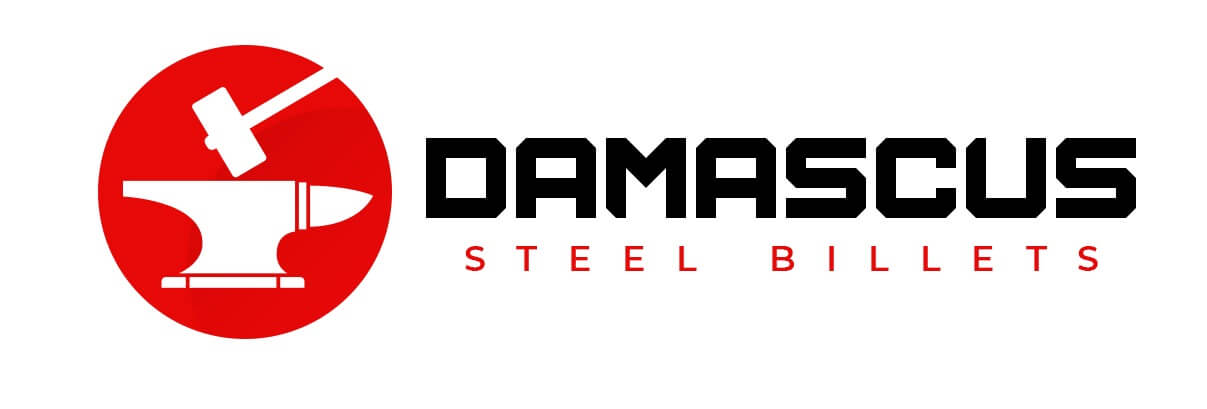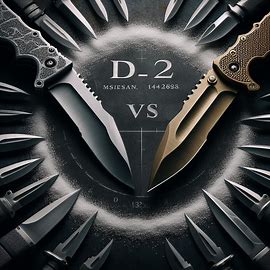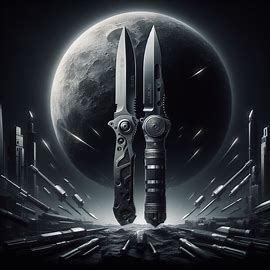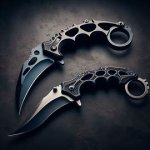The selection between Damasteel and Damascus steel frequently becomes a deciding factor for collectors and fans of high-performance blades. In this detailed blog post, let’s learn more about Damasteel vs Damascus Steel. We’ll review the distinctions between the two, clear up any confusion, and answer any questions you have.
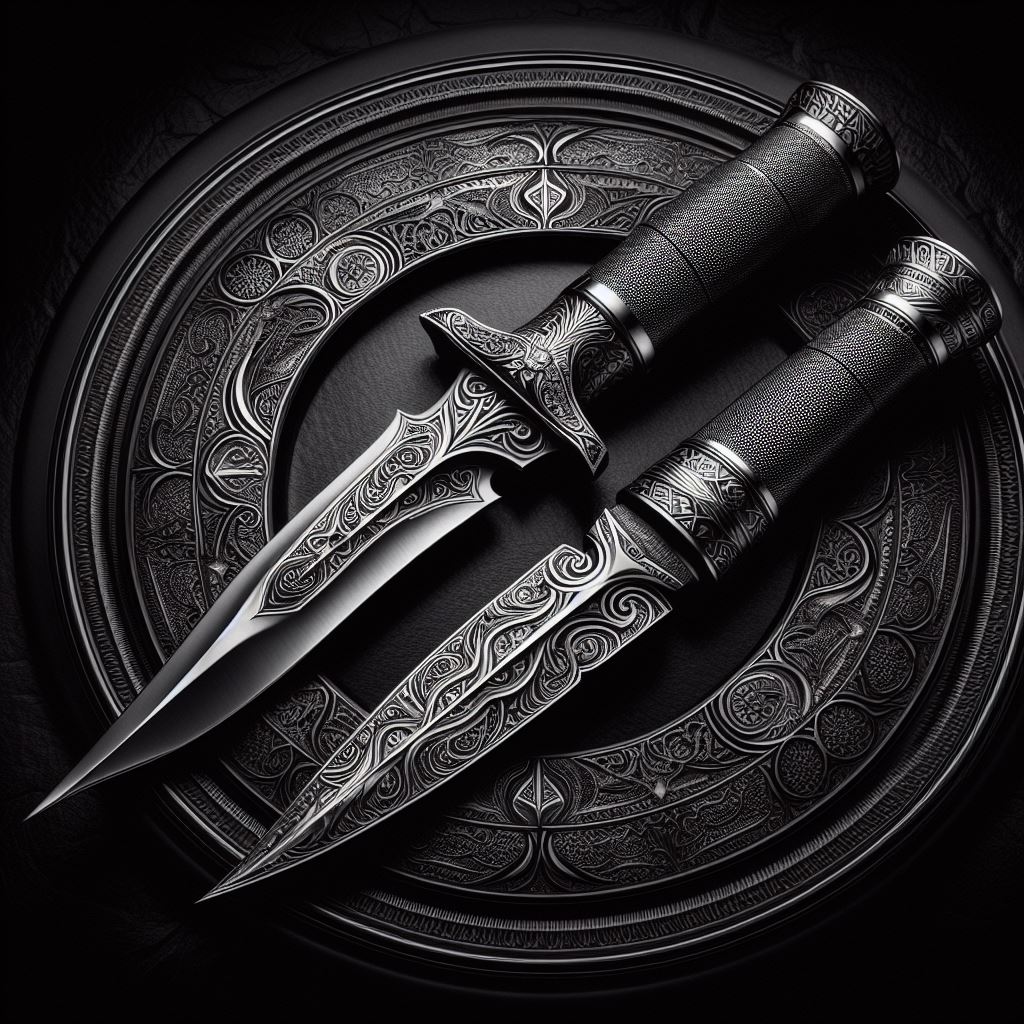
Damasteel vs. Damascus
Understanding Damascus Steel: The Art Behind the Names
Bladesmiths in the Middle East employed Damascus steel, an old steelmaking technology, to fuse many layers of steel to make strong and aesthetically pleasing blades. Forge-welding layers of various steels create a unique Damascus pattern. This pattern is characterized by its wavy look.
The Innovation of Damasteel:
Contrarily, Damasteel is an updated version of the classic Damascus steel. Damasteel AB of Sweden created it, and it’s a beautiful blend of modern metalworking techniques with the classic Damascus design. The powder metallurgy process gives Damasteel, a high-performance stainless steel, remarkable edge retention and durability.
Composition Matters
Damascus Steel Composition
Carbon-rich steels are commonly used in traditional Damascus steel, which makes the pattern’s dark and light layers stand out. The mix of alloys used is usually selected for its hardness-to-toughness balance, however the exact alloys used might differ.
Damasteel Composition
The compositional freedom afforded by Damasteel’s contemporary origins makes it ideal for more controlled musical expression. A combination of corrosion resistance, hardness, and toughness is achieved using high-quality stainless steels like RWL 34 and PMC 27, which are common components. A key factor in the steel’s overall performance is the meticulous control over its composition.
Patterns and Aesthetics
Damascus Steel Patterns
The eye-catching patterns are a hallmark of Damascus steel. The exquisite motifs unique to each blade are developed during the stacking and folding process. Twist, ladder, and raindrop designs are common, giving the final product a unique look.
Damasteel Patterns
Building on its Damascus ancestry, Damasteel refines and expands upon the aesthetically pleasing patterns. Contemporary production methods allow Damasteel to provide elaborate designs, such as the easily recognizable “Vinland” and “Odin’s Eye.” Those searching for a one-of-a-kind blade will like the increased personalization options this provides.
Performance on the Edge
Damascus Steel Performance
Damascus Steel is well-known for both its beauty and its performance. Damascus Steel is famous for making blades that stay sharp and hold their edge well. While forging, the alloys utilized and the heat treatment can affect the total performance.
Damasteel Performance
Damasteel is all about giving it your all. Modern metallurgical methods give Damasteel superior hardness, edge retention, and corrosion resistance. For this reason, it is highly favored by individuals who value the aesthetics and practicality of a blade equally.
Damasteel vs. Damascus
| Feature | Damasteel | Damascus Steel |
| 1. Origin | Sweden (Damasteel AB) | Middle East (Historical origins) |
| 2. Composition | Modern stainless steel alloys (e.g., RWL 34, PMC 27) | Traditional carbon-rich steels |
| 3. Manufacturing | Powder metallurgy | Forge-welding and layering |
| 4. Pattern Control | Precise control for intricate patterns | Patterns result from layering and folding |
| 5. Modern vs. Traditional | Contemporary evolution of Damascus steel | Ancient steelmaking technique |
| 6. Customization | Offers a wide range of customizable patterns | Patterns may be limited to traditional designs |
| 7. Corrosion Resistance | High resistance to corrosion | Susceptible to rust without proper care |
| 8. Toughness | High toughness | Varies based on specific alloys and heat treatment |
| 9. Edge Retention | Excellent edge retention | Good, but performance may vary |
| 10. Hardness | Enhanced hardness due to modern metallurgical processes | Varies based on the specific steels used and heat treatment |
| 11. Availability | Available commercially | Can be handcrafted or purchased from artisans |
| 12. Machinability | Easier to machine | May pose challenges during the forging process |
| 13. Artisan Appeal | Appeals to those who appreciate modern craftsmanship | Appeals to traditionalists and those valuing historical methods |
| 14. Price Range | Typically higher price point due to modern processes | Varies widely based on craftsmanship and design |
| 15. Heat Treatment | Controlled and optimized for performance | Traditional heat treatment methods |
| 16. Layer Consistency | Consistent layering due to modern manufacturing techniques | Variability in layer consistency depending on craftsmanship |
| 17. Historical Significance | Reflects a modern interpretation of Damascus steel | Holds historical significance in the development of blades |
| 18. Resistance to Wear | Resistant to wear and abrasion | Depends on the specific steels used and heat treatment |
| 19. Modern Alloys | Incorporates advanced stainless steel alloys | Traditional steels with a focus on carbon content |
| 20. Versatility | Suitable for a wide range of applications | Versatile but may require proper care and maintenance |
| 21. Blade Performance | High-performance characteristics | Good performance, especially in well-crafted blades |
| 22. Modern Artistry | Often seen as a contemporary art form | Rooted in historical craftsmanship and artistry |
| 23. Resistance to Stains | Resistant to staining due to high chromium content | May stain if not properly cared for |
| 24. Weight | Weight may vary based on specific alloys | Weight may vary based on layering and forging techniques |
| 25. Modern Processes | Utilizes state-of-the-art metallurgical processes | Crafted using traditional forging and heat treatment methods |
| 26. Blade Sharpness | Holds a sharp edge for extended periods | Sharp, but frequency of sharpening depends on use |
| 27. Complexity of Patterns | Offers intricate and complex patterns | Patterns can be intricate but may be limited by traditional methods |
| 28. Contemporary Appeal | Attracts those who value innovation and modern aesthetics | Appeals to those who appreciate the historical and artisanal aspects |
| 29. Resistance to Chipping | Resistant to chipping due to improved toughness | May be susceptible to chipping depending on craftsmanship |
| 30. Craftsmanship Techniques | Involves advanced forging and machining processes | Requires skilled craftsmanship in layering and folding |
| 31. Blade Maintenance | Requires standard maintenance practices | May require more attention to prevent rust and staining |
| 32. Unique Alloys | Utilizes specific Damasteel alloys for performance | Relies on the combination of traditional steels |
| 33. Blade Variety | Offers a broad range of patterns and designs | Patterns may be limited by the artisan’s skill and style |
| 34. Availability of Blanks | Readily available for purchase | Artisan-dependent; may require custom ordering |
| 35. Modern Innovation | Represents a modern evolution of historical techniques | Rooted in ancient techniques with limited modern innovations |
| 36. Blade Flexibility | Exhibits good flexibility while maintaining strength | Flexibility may vary based on craftsmanship and steels used |
| 37. Contemporary Craftsmanship | Reflects advancements in metallurgy and manufacturing | Preserves traditional craftsmanship with historical methods |
| 38. Cutting Performance | Known for superior cutting performance | Offers good cutting performance, but quality depends on craftsmanship |
| 39. Availability of Information | Information widely available due to commercial production | Information may be less standardized due to artisanal methods |
| 40. Blade Longevity | Offers excellent longevity with proper care | Longevity may vary based on the quality of craftsmanship |
| 41. Adoption in the Market | Increasing popularity in the knife market | Widely adopted historically, with a resurgence in popularity |
| 42. Blade Thickness | Thickness may vary based on design preferences | Thickness may vary based on the artisan’s style and preferences |
| 43. Modern Technology | Incorporates modern technology in steel production | Primarily relies on traditional blacksmithing techniques |
| 44. Water Resistance | Resistant to water and moisture due to stainless nature | Requires protection from moisture to prevent rust |
| 45. Mass Production | Suitable for mass production due to modern processes | Often involves more labor-intensive, artisanal production |
| 46. Blade Sharpness Retention | Excellent edge retention over time | Retains sharpness well, but may require more frequent sharpening |
| 47. Blade Flexibility Retention | Maintains flexibility with consistent performance | Flexibility may diminish over time depending on usage |
| 48. Personalization | Allows for intricate and personalized designs | Personalization may be limited by traditional methods |
| 49. Resistance to Pitting | Resistant to pitting due to the stainless nature | Pitting may occur if not properly cared for |
| 50. Trends in the Industry | Represents a modern trend in high-end knives | Traditional craftsmanship is appreciated with a niche market |
Frequently Asked Questions
Is Damascus steel prone to rust?
The carbon-rich steels used to make traditional Damascus steel make it rusty if not treated correctly. As a stainless steel, damasteel resists corrosion and rusts less easily than other metals.
Are Damascus and Damasteel patterns the same?
Layered designs are common to Damascus and Damasteel, although contemporary manufacturing processes allow Damasteel patterns to be more complex and diverse.
Which is better for a high-performance blade?
Because of its regulated composition and advanced metallurgical methods, Damasteel is often used for high-performance blades. It offers higher hardness, edge retention, and corrosion resistance.
Conclusion
In the age-old dispute between Damasteel vs Damascus, collectors and knife aficionados may appreciate both steels’ distinct advantages. It all comes down to personal taste and the blade’s intended usage when deciding between classic Damascus steel, which has a rich history and beautiful appearance, and Damasteel, which offers cutting-edge performance. Regardless of your preference, you will undoubtedly possess a work of art that skillfully blends aesthetics and uses in blades.
